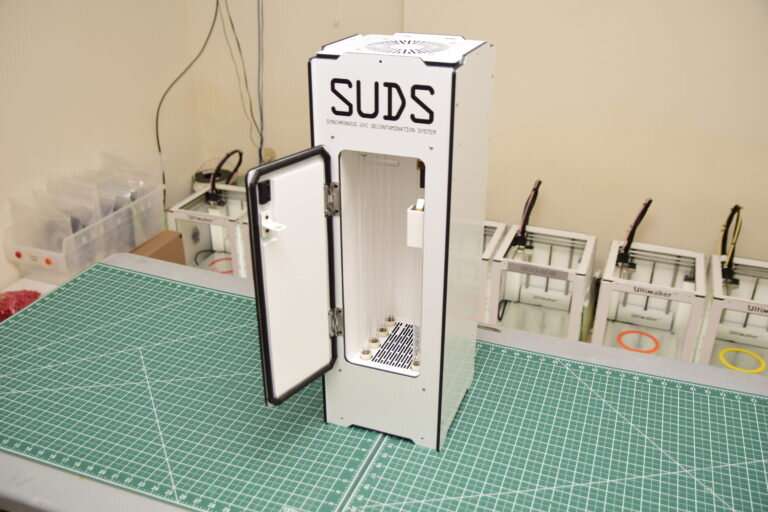Synchronous UV Decontamination System, or SUDS. Credit: Case Western Reserve University
A device that aims to decontaminate N95 respirators in roughly a minute has been created by a team at the Larry Sears and Sally Zlotnick Sears think[box] at Case Western Reserve University, working with researchers at Cleveland Clinic.
The invention, the Synchronous UV Decontamination System, or SUDS, could be especially useful to small- and medium-sized medical centers. Large-scale industrial sterilization systems that sterilize thousands of masks at a time can typically take 30 to 60 minutes for safe reuse by medical staff.
"SUDS is designed to be more affordable and accessible to small and rural clinics that don't have the staffing or experience to run big industrial systems," said Ian Charnas, director of innovation and technology at Sears think[box], the Case Western Reserve's seven-story, 50,000-square-foot innovation center.
The research team, co-directed by Jacob Scott, MD, a physician researcher at Cleveland Clinic's Department of Translational Hematology and Oncology Research and a clinical assistant professor at the CWRU School of Medicine, has released the design under a non-commercial-use-only creative commons license.
Meeting a growing need—safely, quickly
Ideally, a new N95 respirator would be used for each clinical encounter to minimize the transmission of infectious diseases that are airborne or transmitted by respiratory droplets.
However, crises such as the current COVID-19 pandemic can create shortages that necessitate conservation of such equipment. Among potential methods for decontamination, previous work has suggested the UV-C germicidal irradiation (UVGI)—used by SUDS—results in less physical deformation than other types of irradiation and also operates more quickly than steam or vaporized hydrogen peroxide.
Using UVGI for decontamination, SUDS is designed to be compact and rapidly deployable at the point-of-care to deliver the necessary dose of UV-C radiation—in one minute—allowing care-providers to quickly and safely reuse their masks following patient encounters.
"Our preliminary virology results meet the U.S. Food and Drug Administration's virus-reduction guidelines for devices like this," said Charnas.
As designed, a care provider would remove and place their N95 in SUDS after exiting an intensive-care unit, and their respirator would be decontaminated in the time it takes to remove their gloves and gown and wash their hands. The SUDS door then opens automatically so the decontaminated mask can be removed and immediately re-worn, minimizing the need for re-fitting that can delay busy clinicians.
The patent-pending prototype, supported through a COVID rapid-response fund established by tech entrepreneur and CWRU alum Miguel Zubizarreta, is built out of fire-rated aluminum composite for its durability and low cost. Inside the chamber, eight high-output bulbs provide the UV-C dosage needed to decontaminate the respirator. The single-door design improves upon existing two-door chambers which cannot be placed against a wall or in a corner, an important factor in already-crowded clinical units.
Provided by Case Western Reserve University























